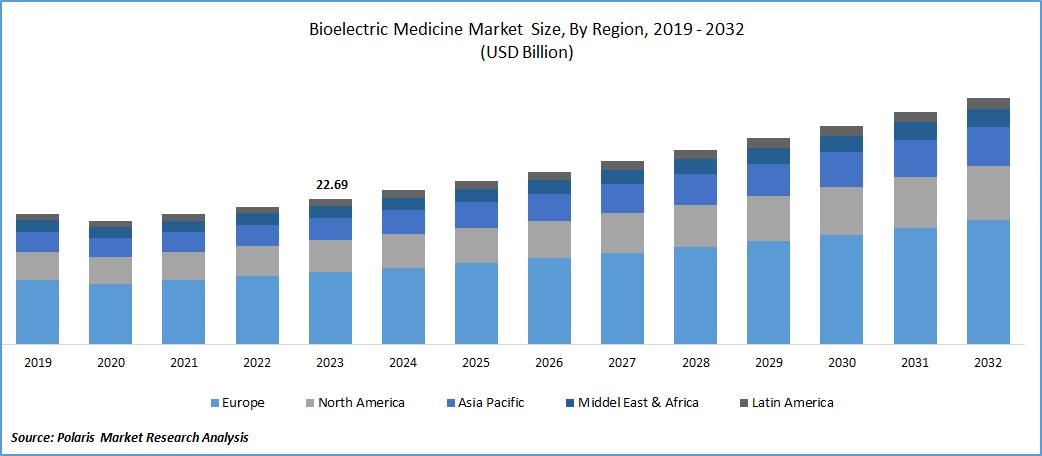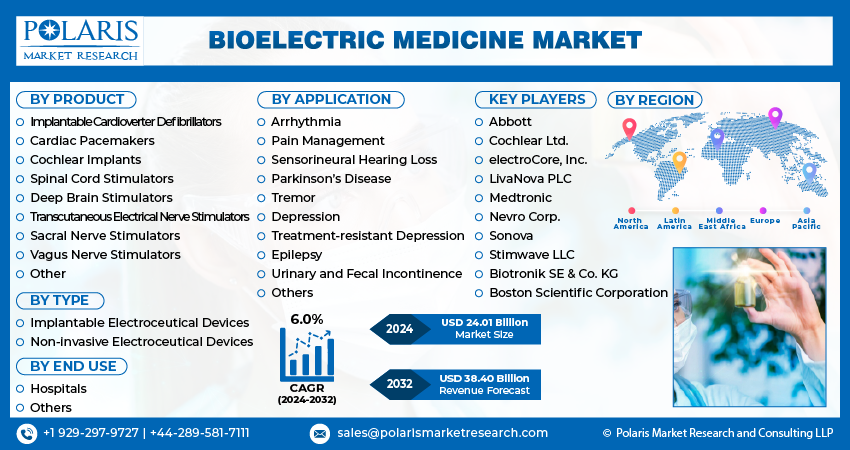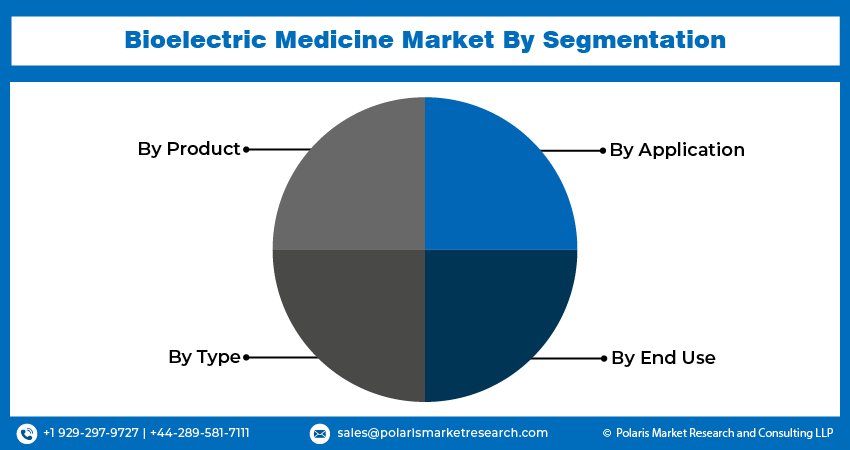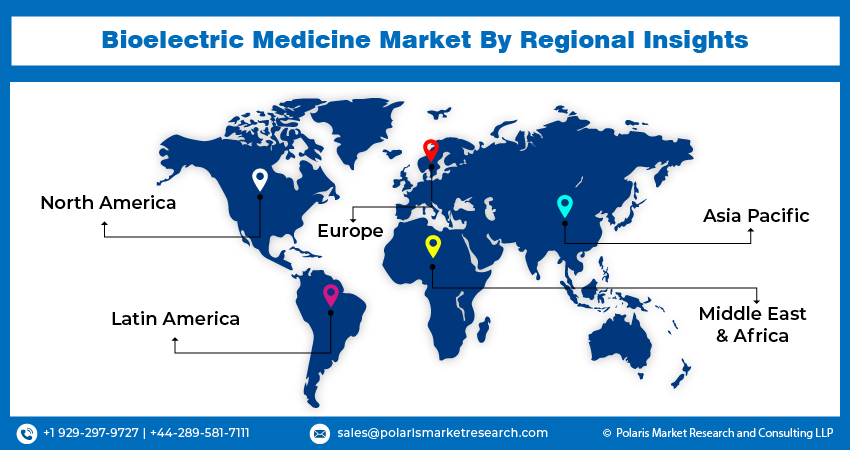
Bioelectric Medicine Market Share, Size, Trends, Industry Analysis Report
By Type (Implantable Electroceutical Devices, Non-invasive Electroceutical Devices), By Product, By Application, By End-use, By Region, And Segment Forecasts, 2024 - 2032
- Published Date:Mar-2024
- Pages: 118
- Format: PDF
- Report ID: PM4389
- Base Year: 2023
- Historical Data: 2019-2022
Report Outlook
The global bioelectric medicine market was valued at USD 22.69 billion in 2023 and is expected to grow at a CAGR of 6.0% during the forecast period.
Key drivers for market growth include the increasing prevalence of chronic and acute conditions, a rising geriatric population, advancements in product development, and initiatives spearheaded by key companies and organizations. Notably, in January 2022, the Alliance for Advancing Bioelectronic Medicine initiated the first Bioelectronic Medicine Day, featuring a health awareness campaign aimed at supporting advancements and efforts in the field of bioelectronic medicine.
According to data from the Centers for Disease Control and Prevention, cardiovascular diseases constitute a leading cause of mortality across diverse demographic groups in the United States. In 2021, approximately 695,000 individuals succumbed to heart diseases, representing one-fifth of all recorded deaths. Additionally, the projected global economic burden of cardiovascular diseases (CVDs) is expected to reach approximately USD 1,044 billion by the year 2030.

To Understand More About this Research:Request a Free Sample Report
Market faces challenges due to stringent government regulations governing the development and production of medical devices like implantable cardioverter defibrillators, cardiac pacemakers, and neuromodulation devices. These devices undergo extensive clinical trials before receiving premarket approval (PMA), leading to a substantial increase in manufacturing costs. Moreover, the occurrence of product recalls presents a significant challenge that may negatively impact the growth of the market.
Industry Dynamics
Growth Drivers
Increasing Chronic Diseases
Bioelectric medicine, at the intersection of bioengineering, molecular medicine, and neuroscience, focuses on the development of technologies that stimulate nerves to regulate biological processes during disease treatment. Market is anticipated to be significantly driven by the increasing prevalence of chronic diseases, particularly cardiac and neurological disorders. For instance, according to the Centers for Disease Control and Prevention (CDC), over 610 thousand people in the U.S. succumb to heart diseases annually, with coronary heart disease alone accounting for over 370,000 deaths. The escalating demand for advanced bioelectric medicine to address these chronic disorders is poised to contribute to substantial growth in the market.

Report Segmentation
The market is primarily segmented based on product, type, application, end use, and region.
|
By Product |
By Type |
By Application |
By End Use |
By Region |
|
|
|
|
|
To Understand the Scope of this Report:Speak to Analyst
By Product Analysis
ICDs Segment Accounted for the Largest Market Share in 2023
ICDs segment accounted for the largest share. This is due to widespread application of ICDs in the treatment of arrhythmias. The escalating prevalence of sudden cardiac arrests, coupled with the growing global geriatric population, has contributed to the increased adoption of ICDs. Additionally, advancements in product development within this segment are anticipated to further drive market growth.
Vagus nerve stimulators segment will grow rapidly. global population is steadily aging, leading to an increased prevalence of chronic diseases. As technological advancements continue to enhance medical devices, vagus nerve stimulators have emerged as an effective treatment option. There is a growing demand for add-on therapies, and vagus nerve stimulation is proving to be valuable in addressing various conditions, including epilepsy and migraines. The substantial unmet medical needs in these disease segments further contribute to the anticipated growth of the market. Overall, these factors collectively drive the expansion of this segment in the foreseeable future.
The European Parkinson's Disease Association (EPDA) reports a global prevalence of around 6.3 million individuals living with Parkinson's disease. Within Europe, specifically, there are approximately 1.2 million patients affected by Parkinson's disease. This statistic highlights the significant impact of Parkinson's disease on a global scale and underscores its prevalence in the European population. The EPDA's data contributes to a better understanding of the scope and distribution of Parkinson's disease, aiding in efforts to address the challenges posed by this neurodegenerative disorder.
By Type Analysis
IED Devices Segment Held the Significant Market Share in 2023
IED devices segment held the significant market share. This growth is primarily due to their widespread application in treating various conditions such as arrhythmia, chronic pain, ischemia, tremor, & sensori-neural hearing loss. The market is categorized into implantable and non-invasive electroceutical devices based on type. Manufacturers are actively concentrating on introducing advanced products to meet the unmet needs of customers in this evolving healthcare landscape.
Non-invasive electroceutical devices segment is expected to gain substantial growth rate. This is attributed to advancements in technology, increased research, and development investments by companies for innovative product development, and the growing healthcare awareness and popularity of electroceuticals, especially in developing countries.
By Application Analysis
Arrhythmia Segment Held the Significant Market Share in 2023
Arrhythmia segment held the significant market share. This dominance is primarily attributed to the increasing prevalence of arrhythmia, a condition characterized by irregular heart rhythms. The treatment of arrhythmia often involves the utilization of implantable cardioverter-defibrillators and cardiac pacemakers, driving the demand and adoption.
Epilepsy segment will grow with substantial pace. This growth is primarily attributed to advancements in treatment options, particularly the utilization of vagus nerve stimulators. Companies and research institutes are actively directing their efforts towards innovative product developments within this segment, contributing significantly to the overall growth of the bioelectric medicine industry. The continuous exploration of novel therapies and the development of advanced technologies are driving the expansion of treatment options for epilepsy.
A study conducted by the University of Pittsburgh Schools of Health Sciences in May 2023 suggested that Vagus Nerve Stimulation (VNS) therapy might be beneficial for a broader spectrum of patients than previously understood. The study's results indicated that individuals experiencing focal seizures or motor seizures were more likely to respond positively to VNS treatment. This discovery implies that VNS therapy could potentially offer benefits to a larger group of patients than initially believed.

Regional Insights
Europe Region Dominated the Global Market in 2023
Europe region dominated the global market. Region’s growth is due to robust presence of medical device manufacturers within the region. Additionally, the well-established healthcare system and the accessibility of advanced products have contributed significantly to the growth. The presence of major manufacturers in the field of bioelectric medicine, coupled with a well-developed healthcare infrastructure, has served as a driving force for the regional market's expansion.
The Asia Pacific will grow with substantial pace. This growth is attributed to the increasing elderly population in Asian countries. Additionally, the surge in the prevalence of chronic ailments, including cardiac arrhythmias, Alzheimer's disease, & epilepsy, is expected to stimulate the adoption of electroceuticals in the region. The combination of these factors contributes to the significant growth potential of the bioelectric medicine market in the region.

Key Market Players & Competitive Insights
The market exhibits a high degree of fragmentation, characterized by the presence of numerous manufacturers. Key players offer a diverse range of advanced electroceuticals through robust global distribution channels, intensifying competition and creating pressure on pricing strategies. This competitive landscape is anticipated to impact profit margins. Leading companies actively engage in various strategies such as new product development, collaborations, mergers and acquisitions, and regional expansions. These initiatives aim to not only enhance their existing product portfolios but also extend their geographical reach, capturing a larger share of the market's revenue.
Some of the major players operating in the global market include:
- Abbott
- Biotronik SE & Co. KG
- Boston Scientific Corporation
- Cochlear Ltd.
- electroCore, Inc.
- LivaNova PLC
- Medtronic
- Nevro Corp.
- Sonova
- Stimwave LLC
Recent Developments
- In July 2023, Boston Scientific has received FDA approval for its Vercise Neural Navigator 5 software. Developed to complement the Vercise Genus deep brain stimulation (DBS) systems, this software offers clinicians straightforward and practical data for treating individuals with Parkinson's disease or essential tremor. The software enables efficient programming of the DBS system, facilitating clinicians in delivering optimal treatment to patients.
- In June 2023, BIOTRONIK has reported the successful global implantation of its latest implantable cardiac monitor, BIOMONITOR IV. This device is engineered to enhance the efficiency of cardiac arrhythmia monitoring through the integration of artificial intelligence technology. By combining the company's SmartECG technology with the AI, the device can decrease false positive detections by nearly, 86% while maintaining accuracy in identifying 98% of the true episodes.
- In February 2023, LivaNova introduced SenTiva DUO, a novel implantable pulse generator designed to address drug-resistant epilepsy in patients. The device is specifically crafted for delivering VNS therapy and features a dual-pin header.
Bioelectric Medicine Market Report Scope
|
Report Attributes |
Details |
|
Market size value in 2024 |
USD 24.01 billion |
|
Revenue forecast in 2032 |
USD 38.40 billion |
|
CAGR |
6.0% from 2024 – 2032 |
|
Base year |
2023 |
|
Historical data |
2019 – 2022 |
|
Forecast period |
2024 – 2032 |
|
Quantitative units |
Revenue in USD billion and CAGR from 2024 to 2032 |
|
Segments covered |
By Product, Type, By Application, By End Use By Region |
|
Regional scope |
North America, Europe, Asia Pacific, Latin America, Middle East & Africa |
|
Customization |
Report customization as per your requirements with respect to countries, region, and segmentation. |
FAQ's
Bioelectric Medicine Market Size Worth $ 38.40 Billion By 2032.
The top market players in Bioelectric Medicine Market include Medtronic, Abbott, Boston Scientific, Cochlear, LivaNova, Biotronik, electroCore.
Europe is region contribute notably towards the Bioelectric Medicine Market.
The global bioelectric medicine market is expected to grow at a CAGR of 6.0% during the forecast period.
Bioelectric Medicine Market report covering key segments are product, type, application, end use, and region
